The next-gen MacBook Pro with Retina Display Review
by Anand Lal Shimpi on June 23, 2012 4:14 AM EST- Posted in
- Mac
- Apple
- MacBook Pro
- Laptops
- Notebooks
Last year when I wrote about the new MacBook Airs I offered two forward looking paragraphs:
What happens from here on out is what's really interesting. Intel has already committed to moving the TDP of its mainstream parts from 35W - 45W down to 10 - 20W. Since the Air is the new mainstream Mac notebook, Apple has already made that move. The performance in this 10 - 20W segment is going to get much better over the next two years, particularly once Haswell arrives.
The Thunderbolt Display is the first sign of what's to come. Moving IO controllers and expansion into the display, and potentially even moving discrete GPUs out of the notebook are all in store for us. Apple is really ahead of the curve here, but it's easy to imagine a future where laptops become a lot more like the new Air and shift to a couple high bandwidth ports instead of numerous lower bandwidth connections.
Perhaps I was being too aggressive in the prediction of a couple of high bandwidth ports. After all, the next-generation MacBook Pro with Retina Display features four such IO ports (2 x Thunderbolt and 2 x USB 3.0). But you get my point. Gigabit Ethernet and Firewire 800 are both gone. The discrete GPU is still present but I suspect even its days are numbered, at least inside the chassis. The personal computer as we knew it for so long, is changing.
The personal computer is getting thinner, lighter, more integrated and more appliance-like. The movement is no longer confined to just Apple either. The traditional PC OEMs are following suit. Even Microsoft has finally entered the PC hardware business, something it threatened to do for years but hadn't until now. Distribution models will change, the lines between different form factors will continue to blur. What was once a mature industry is going through a significant transformation. It’s exciting but at the same time it makes me uneasy. When I first got into this industry everyone had stories of companies with great ideas that just didn’t make it. As we go through this revolution in computing I’m beginning to see, first hand, the very same.
Apple makes the bulk of its revenue from devices that don’t look like traditional personal computers. For the past couple of years I’ve been worried that it would wake up and decide the traditional Mac is a burden, and it should instead be in the business of strictly selling consumer devices. With its announcements two weeks ago in San Francisco, I can happily say that my fears haven’t come true. At least not yet.
It’s been a while since Apple did a really exciting MacBook Pro launch. Much to my surprise, even the move to Sandy Bridge, the first quad-core in a MacBook Pro, was done without even whispers of a press conference. Apple threw up the new products on its online store, shipped inventory to its retail outlets, updated the website and called it a day. Every iPhone and iPad announcement however was accompanied with much fanfare. The MacBook Pro seemed almost forgotten.
With its WWDC unveil however Apple took something that it had resigned to unexciting, dare I say uncool status, and made a huge deal about it. Two weeks ago Apple did the expected and offered relatively modest upgrades to all of its portable Macs, all while introducing something bold.
Apple calls it the MacBook Pro with Retina Display. You’ll see me refer to it as the next-gen MacBook Pro, Retina MacBook Pro, rMBP or some other permutation of these words.
After using it for the past two weeks I can honestly say it’s the best Mac Apple has ever built. And there’s a lot more to it than hardware.
Portability
If you were hoping for a 15-inch MacBook Air, that’s not what the rMBP is. Instead it is a far more portable 15-inch MacBook Pro. I have to admit I was a bit let down the first time I laid eyes on the next-gen MacBook Pro, it looks good but it doesn’t look all that different. The disappointment quickly faded as I actually picked up the machine and started carrying it around. It’s not ultra light, but man does it make the previous chassis feel dated.
While I never really liked lugging around the old MBP (and it always made me feel like the old fogey at tradeshows where everyone else had something 13-inches or smaller), carrying the rMBP is a pleasure by comparison. Pictures really don’t do it justice. The impressively thin display assembly or overall chassis thickness look neat in a photo but it’s not until you actually live with the rMBP that you can appreciate what Apple has done here. I carry around a 15-inch MacBook Pro because it’s my desktop, and as such it’s incredibly useful to have with me when I travel. For my personal usage model, the Retina MacBook Pro is perfect.
If your workload demands that you need the performance of a MacBook Pro and your lifestyle requires you to carry it around a lot, the reduction in thickness and weight alone will be worth the upgrade to the rMBP. If you spend most of your time stationary however, you’ll have to be sold on the display and internal characteristics alone. The bad news is if the design doesn’t get you, everything else will.

From left to right: 11-inch MacBook Air, 13-inch MacBook Air, 15-inch MacBook Pro, MacBook Pro with Retina Display
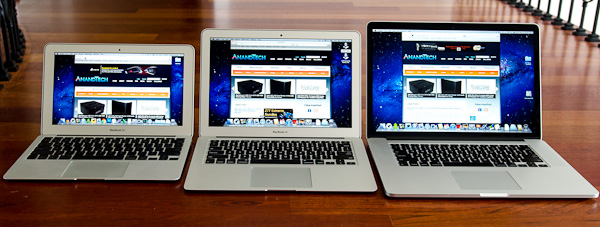
From left to right: 11-inch MacBook Air, 13-inch MacBook Air, MacBook Pro with Retina Display
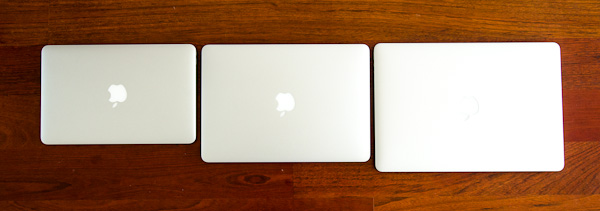
From left to right: 11-inch MacBook Air, 13-inch MacBook Air, MacBook Pro with Retina Display


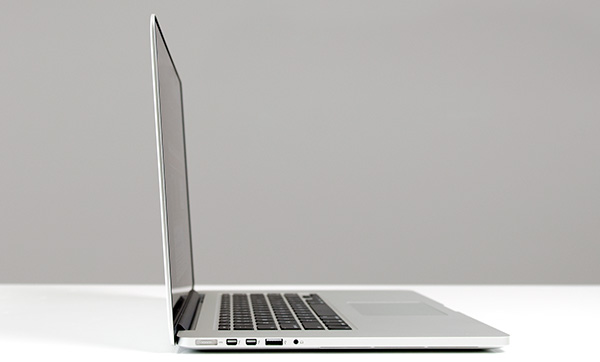
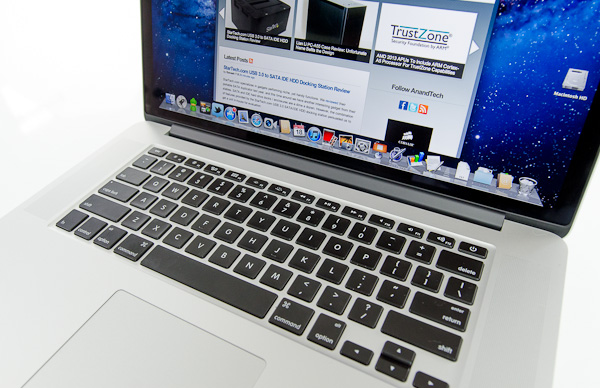
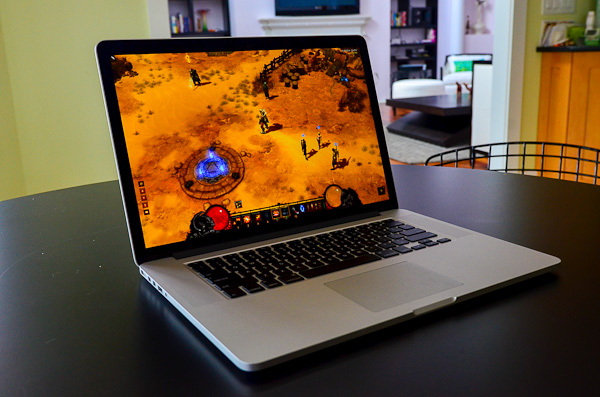
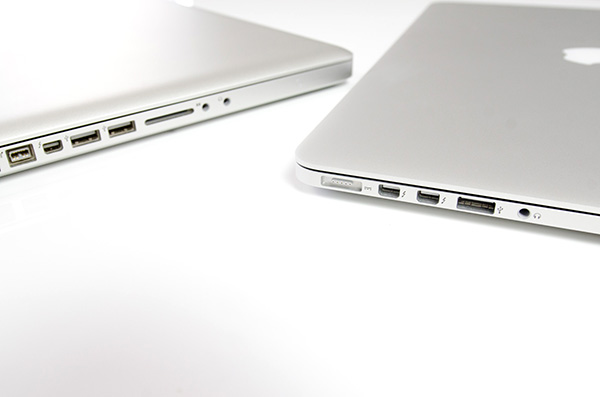
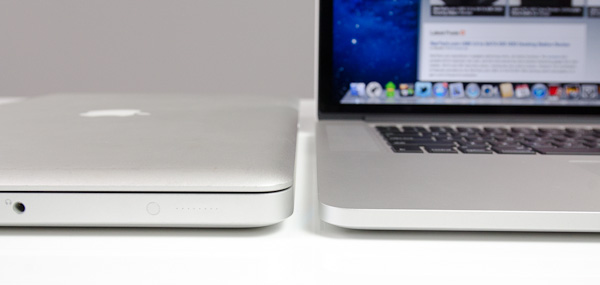








471 Comments
View All Comments
iCrunch - Sunday, June 24, 2012 - link
Agreed. This review is awesome. I hope he's right about the 4K Retina Thunderbolt display, which I'd buy in a heartbeat. One thing I don't get is why so many people and reviewers alike consider the $2,200 price tag extremely and often times too expensive. You're getting the latest and the greatest processors, both CPU and GPU-wise, a generous 8GB of RAM and I find the 256GB SSD to be plenty. After my two 180GB Intel 520 SSD's, this is the largest single SSD that I have ever owned. The upgrades are fair as well as far as doubling the RAM for $200 is concerned. At Apple no less! A few months ago, any setup of 16GB of RAM in 2 SODIMM's was well over $300 and if you go back a few more months, that amount of RAM set you back over a full grand! As in $1,000+I couldn't justify the $600+ price difference for an extra 300MHz in CPU clock and an additional 256GB Flash, though. If the GPU had come with 2GB GDDR5, then maybe, but not as it stands today.
hyrule4927 - Sunday, June 24, 2012 - link
First of all, the 650M may be one of the latest mobile GPU's, but it is pretty far from the greatest. It is a midrange GPU forced to drive an insane resolution with only 1GB of VRAM. And 8GB of RAM isn't "generous", to have any less in a laptop this expensive would be ridiculous. Paying $200 to upgrade to 16GB is a scam, especially considering Apple made the decision to prevent consumers from simply purchasing and installing more RAM on their own (you can find 2X8GB SODIMMs for a bit over $100, no idea what planet you were shopping on where that would cost $1000 at any time in the past year).EnerJi - Sunday, June 24, 2012 - link
I'm sure you can find 8GB of no-name stuff on sale somewhere, but for one example of name-brand memory, Crucial memory goes for $86.99 per 8GB ($173.98 total):http://www.crucial.com/store/listmodule/DDR3/list....
Also, Apple uses low-voltage DDR3-1600, which is lower volume and may be slightly more expensive as a result.
In that light, while $200 to upgrade to 16GB isn't exactly a bargain, it isn't the typical rapacious Apple upgrade prices.
Fx1 - Monday, June 25, 2012 - link
ARE YOU KIDDING? The 650M is running at 900mhz stock! people are clocking this bad boy well over 1050-1100mhzThose are ABOVE 660M GTX Speeds.
Id say Apple has packed in the BEST GPU possible given the thermal limits and size of this notebook.
In windows this MBP will run games at very nice settings and maybe the first Notebook that isn't as thick as an encyclopaedia that can run games on high settings.
Most will never use 8GB of Ram and 16GB is an option so i don't see the issue. Its also custom made which means Walmart RAM prices aren't compatible
hyrule4927 - Monday, June 25, 2012 - link
No, I'm not kidding. Nice capitalization though, it really does wonders for the credibility of your statements. Here are the flaws in your logic. You say that the 650M is the "BEST GPU possible given the thermal limits” with carefully placed capitalization in order to play down the qualifying terms in your statement. Then you suggest overclocking it. If Apple chose this GPU because they were fighting thermal limits, do you really expect it to handle overclocking well? And sure it can run Half Life 2 and Diablo III (an old game, and a game that is hardly demanding by modern standards) at standard resolutions, but users are going to want to game at native resolution on their new retina screen. Too bad Diablo runs at 18 frames per second. It is ludicrous to consider that a playable framerate, and if it can't handle Diablo, it won't be able to handle much of anything at that resolution. Again, that VRAM limitation is a killer. Considering that many popular current games, such as Skyrim, easily consume more than 1GB at 1080p, memory capacity is going to be an enormous bottleneck even when you are nowhere near native resolution. No matter how you want to look at it, a GPU like the 680M is much better suited for that screen, and the 650M doesn't even hold a candle to the performance of that chip.As for the system RAM, while I am sure that you enjoy shopping at Walmart, perhaps you should look on Newegg where you can find a 16GB kit from the manufacturer of your choice for just over $100. Of course you have probably never bought a single computer component in your life, so you can be forgiven for not knowing that. And you describe the "custom" RAM as if it is a selling point. Because everyone knows that proprietary format soldered RAM was included with the best interests of the consumer in mind . . .
iCrunch - Sunday, June 24, 2012 - link
Hi guys, does anyone have this new rMBP (love the abbreviation) and TOSHIBA "SSD "Flash storage"? You can find this in "System Information" under Serial-ATA and it will say either "Apple SSD TS256E" for a Toshiba drive/Flash storage. If you have a Samsung, it will say "Apple SSD SM256E". Naturally, if you have a 512GB drive, it'll display Apple SSD SM(or TS)512E.This should be interesting.
iCrunch - Sunday, June 24, 2012 - link
Thank you, Anand, for the single best and exhaustive review of this gorgeous new powerhouse. I picked one up from an Apple Store, so naturally, I only have the 8GB RAM. I have a 2nd one coming, also a 2.3, but with 16GB and then I will sell this one. That is, if I decide that I truly need and want 16GB. At $200 before any discounts, it sure seems like a worthwhile upgrade either way. There had better not ANYTHING be wrong with ANY other part of my new rMBP, though. lol...pxavierperez - Sunday, June 24, 2012 - link
It's funny how Anand went to great lengths describing, even posting an image as an example, how OSX DPI scaling implementation was superior compared to Window, which really was his point and the point that really mattered to end users, and yet we have Apple haters getting all fumed up just because Anand made one simple typo on the numeric value of Window 7 DPI setting.Sure you can set Windows 7 to scale 200% (2x) but it's flaky, dialog box breaks, inconsistency in rendering objects, and just all around not usable. It's not just all about features it's also about how they are wrapped together to make it work so seamless. Here Apple did a far, far better job than Windows. Which was Anand's point.
spronkey - Sunday, June 24, 2012 - link
All around, it's not a bad review. But I'm disappointed that you still decided to give it an award despite the massive issues:#1 - The soldered RAM.
#2 - The nonstandard SSD form factor.
#3 - The price. Not so much of the machine, but of the upgrades more than anything else.
I'm also disappointed that I didn't see (though may have missed) a bashing of the new MagSafe 2 connector. What a waste of time - just make the chassis ever so slightly thicker. Or, do what other manufacturers do and mould a port around it. Then make it look good.
However. For a Pro machine to be so bastardised... 8GB is not plenty of RAM. Look at the rate we've been increasing RAM requirements over the past few years - it's speeding up, not slowing down. In a year's time, 8GB will probably be standard on half new machines, and in 2 years it'll be very limiting.
I'm also disappointed that these points above aren't also factored in to a good bashing about Apple's very minimal warranty, and very expensive AppleCare product.
I've owned Macs for years - in fact all bar 1 of my portables have been Apple machines; the software/hardware integration just runs circles over the Windows slabs, but I'm really starting to get pissed off with Apple's blatant lockdowns and price gouges. It's anticompetitive and bad taste.
Ohhmaagawd - Sunday, June 24, 2012 - link
I wish it had socketed RAM and a standard SSD too.But fact is most people don't upgrade their machines (although pro users are much more likely). Apple really wanted the thinnest laptop possible with the longest battery life possible. Those goals conflict with upgradability. And I would guess Apple just doesn't care about upgradability. They don't want people opening their cases.
The future for apple laptops is clear: you won't be able to upgrade anything. So better buy what you need to start with.
If you can't deal with that, buy elsewhere.